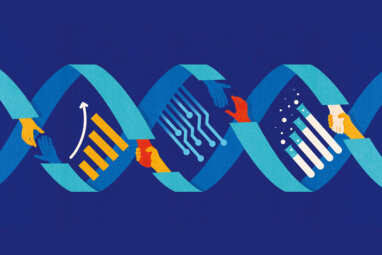Building the Right Ecosystem for Innovation
As companies grapple with uncertainty and change, they must collaborate in new ways with unlikely partners.
When markets become disrupted by new technologies and competitors, many legacy companies struggle to keep up. They are often simply ill-prepared to develop new products and services in the midst of the uncertainty. Rather than attempting to go it alone in such circumstances, some companies reach out to partners with an eye toward building a broader ecosystem that will boost their competitive strength. But what types of ecosystems will work best in a dynamic environment?
Perhaps the most common forms of ecosystems are centralized, where the company functions as the “hub.” These tend to work well in stable environments where the key issues have already been worked out. In Amazon.com Inc.’s ecosystem for ebooks, for example, the online retailer works with the maker of its Kindle tablets and an array of book publishers but keeps the respective partners separate from one another.
However, in many settings today, the requirements are fluid and the objectives less defined. What’s needed, therefore, isn’t a broker or intermediary to link the various partners but an orchestrator who can find connections among different partners and encourage them to work directly with one another to identify new or nascent opportunities. Rather than building a centralized ecosystem, the orchestrator’s job is to create what we call an adaptive ecosystem, where partners develop significant projects or innovations together.1 For companies, this requires both imagination and flexibility.
Driving Innovation
In our most recent research on how organizations generate value from their corporate alliances and partnerships, we’ve studied how certain companies, including Samsung, Mastercard, Lowe’s, and Cisco Systems, have used adaptive ecosystems to define new offerings (see “About the Research”). Unlike traditional, centralized ecosystems, which tend to rely on partners that have fairly obvious tie-ins to the existing business model (as Amazon had with the Kindle maker and book publishers), companies using adaptive ecosystems frequently work with partners with less conventional capabilities.2 For this reason, we refer to them as “uncommon partners.” (See “Centralized vs. Adaptive Ecosystem Strategies.”)
Samsung Electronics Co. Ltd.’s recent experience developing a personal-health monitoring business offers a good example. In the past, the company’s innovation efforts were geared toward being a fast follower as opposed to a market leader. To support its goals, Samsung coordinated innovation activities centrally through its strategy and innovation center. But as the company evaluated opportunities in personal-health monitoring, it reached out to more than 20 startups and academic researchers working in fields related to blood pressure, hydration, and nutrition. In addition, it developed a close working relationship with Nestlé S.A., the Swiss food conglomerate. Although Nestlé had no experience in consumer electronics, it had done significant research on the impact of nutrition on the human body.
Assembling a network of other outside partners, Samsung then set out to develop a platform (which it calls “The Voice of the Body”) where users and their doctors can monitor health and medical issues using the latest technology. In contrast to how things work in a centralized hub ecosystem (where each partner coordinates separately with the company), the partners work as a team to create new tools for improving medical care. Eventually, Samsung envisions introducing devices capable of collecting users’ biological data and interpreting it in real time, refining the results using algorithms based on an elaborate user database. Although Samsung’s focus is electronics, the opportunities could extend beyond monitoring devices. The company also sees possibilities for developing food products that have clinically proven health benefits.
In adaptive ecosystems, it can be difficult to predict all of the required expertise and capabilities. As opportunities arise, orchestrators need to be prepared to revisit the mix of partners. The payment processing industry, which is undergoing tremendous change, provides a case in point. Over the years, Mastercard International Inc. has competed against Visa and American Express with a centralized ecosystem strategy in which it interacts seamlessly with a long list of banks and merchants that use Mastercard’s infrastructure to process payments from its customers. More recently, however, Mastercard saw opportunities to broaden its scope of business. Rather than restrict itself to credit cards, the company wanted to develop new offerings in the growing realm of digital payments. To do this, it needed an adaptive ecosystem that could develop new offerings tailored to emerging consumer needs. In London, for example, it began working with Transport for London (the authority in charge of the city’s subway, train, and bus transportation), Cubic Transportation Systems (the transit infrastructure provider), and retailers in the consumer goods business.
So far, Mastercard’s efforts to move into new areas with new partners have been encouraging. Since payment solutions can be easily embedded in smartphones, configuring Mastercard’s payment platform to pay for train and bus use is a no-brainer. But by working with partners and using both historical data about commuter behavior and a steady stream of new data, Mastercard is also hoping to drive improvements in the commuting experience. For example, in an effort to shift ridership away from the busiest periods of the day, it could offer commuters discounts at coffee shops and other businesses if they opted not to use transportation systems during certain times of day. Mastercard executives we interviewed suggested that relatively small changes in consumer behavior — as little as a few minutes at the right times — could make a big difference. Indeed, for every 1% shift in peak demand, large cities such as London, Chicago, or New York City might save millions of dollars in delayed capital expenditures each year and, more important, create a more pleasant experience for travelers.
Implementing an Adaptive Ecosystem Strategy
How does a company implement an adaptive ecosystem strategy? Based on our research, we have identified a series of essential activities.
Define the ‘Battlefield’
While centralized ecosystem strategies depend on having specific, well-defined problems and solutions (how to sell ebooks online or how to equip houses with solar panels, for example), adaptive ecosystem strategies are suited for situations where the problem and the solution are uncertain or still being sorted out. As a result, you need to start by defining the “battlefield” — or the area to explore. From there, you can begin to assemble an ecosystem to explore the challenge and refine it as your understanding about the opportunity evolves. Mastercard, for example, wanted to learn how it could use artificial intelligence (AI) in its business. To understand how AI could be integrated with payment solutions, it reached out to Pizza Hut LLC and SoftBank Corp., a Japanese telecommunications and internet company that has investments in a number of technology startups.
Working together, the companies developed a new mobile customer interface using Pepper, Softbank’s humanoid robot, as a diner’s assistant in some Pizza Hut restaurants. The robot identifies customers from their mobile phones, recommends the day’s specials, and takes orders. Mastercard’s technology allows customers to pair their phones with the robot for identification purposes and to process transactions. The robot, in effect, assumes the role of cashier and lightens the load for servers. For Mastercard, this move into robotics represents a radical step.
Use ‘Bat Signals’ to Attract Partners
After defining the battlefield, orchestrators need to find and attract the right partners. In our experience, some of the most successful adaptive ecosystem strategies have been achieved when companies were able to connect with uncommon partners on the outer fringes of their industries — or even beyond the traditional boundaries of their industries. However, identifying the capabilities required for innovation can be challenging: You don’t know precisely what you will need along the journey, and you simply don’t know what you don’t know.
Orchestrators need to be willing to experiment with new ways of doing things. Consider this example: Lowe’s Companies Inc., a home improvement retail chain based in North Wilkesboro, North Carolina, wanted to explore opportunities in the emerging 3-D printing and additive-manufacturing business. So, it reached out to a range of potential partners already in that market, including a developer of 3-D designs, a provider of high-volume distributed 3-D printing, an industrial 3-D printing company, a design agency, and a sensor manufacturer. Kyle Nel, founder of Lowe’s Innovation Labs, described this part of the process as putting out “bat signals,” in hopes that the right set of partners would come together. Management recognized that moving away from the company’s established retail business and into a new market would be challenging and require a new business model — one flexible enough to enable customers to design things they could print from stores. The partners Lowe’s recruited to the new ecosystem brought not only the capabilities necessary to enable the new business venture, but also key insights about how to attract customers to the offering. To promote the new capability, Lowe’s designed a media campaign and released a series of videos, which in turn have attracted some additional new partners.
Eager to develop new ideas for growing its overall business, Cisco Systems Inc., a networking hardware company based in San Jose, California, is taking a similar approach. It has released a series of videos describing initiatives it has explored in conjunction with other companies through CHILL (Cisco Hyperinnovation Living Labs) — undertakings that Cisco says likely would have been too difficult, too expensive, or too intangible to pursue on its own.3 In the area of health care, for example, Cisco recently brought together senior executives from Walgreens, Vocera Communications, the University of California at San Francisco, and other organizations for a two-day meeting. Participants worked as an adaptive ecosystem on new initiatives such as virtual care and connected hospitals. Cisco has since launched CHILL-X startups made up of companies cofounded by the ecosystem and piloted by an experienced CEO.
For its part, Samsung has taken a slightly more conservative approach. It organizes networking events to which it invites potential partners (including competitors) and experts from different disciplines. Recently, for example, it brought people together to discuss topics including medical imaging, solar-enabled transportation solutions, pediatrics, and AI. Samsung uses the conferences to gauge which partners are most valuable and then initiates discussions with them.
Connect Uncommon Partners
While centralized ecosystems are frequently based on arm’s-length transactions that keep partners separate from one another, adaptive ecosystems are structured to encourage cross-fertilization. Their effectiveness depends on close and supportive collaborations between the organizing company and the partners, and also among the partners. Moreover, adaptive ecosystems perform best when made up of partners from outside one another’s traditional ecosystems. Having uncommon partners helps the company at the center explore unfamiliar terrain.
Making this happen can be challenging because most of the partners have never worked with one another and there are few models for such collaboration. Cisco’s recent work with companies including DHL, Caterpillar, and Airbus to create a new digital supply chain provides a useful example. In 2015, Cisco brought more than 80 people together in Berlin for a brainstorming session to think of ways in which manufacturers could manage global inventory in a more flexible manner and better forecast problems with component supplies before they arise. The collaborators sought ways to enable companies to track shipments more precisely with sensors and authenticate the sources of components with blockchain technology. The possible uses of blockchain technology in supply chain management are wide-ranging. In the near term, companies will be able to use secure, digitized supply chains to monitor and authenticate specific spare airplane parts, for instance, or the origins of the diamonds used in jewelry. Such breakthroughs would not have been possible without an ecosystem of uncommon partners.
Companies with experience in adaptive ecosystems are finding that, by definition, collaborations don’t follow a set pattern. Thus, Cisco has found advantages in working with a core group of partners across multiple projects. According to Kate O’Keeffe, senior director of Cisco’s CHILL initiative, such stability allows people on both sides to gain critical experience they can apply to other projects.
Glue the Partners Together
Centralized and adaptive ecosystems have one important thing in common: Orchestrators provide the “glue” that gives the ecosystem its infrastructure and holds it in place. For Lowe’s, the glue for the adaptive ecosystem is the network of physical stores and the direct connection to customers that those stores provide. For Samsung, it’s the ability to manufacture or distribute electronics on a massive scale. In Amazon’s Kindle initiative, the glue for the centralized ecosystem is the online retailer’s distribution power, tablet design, and digital-rights management software. A well-recognized brand can also act as glue.
But adaptive ecosystems give companies opportunities to develop new forms of glue that connect multiple partners to one another and become the ecosystem’s distinctive source of value. For example, in Samsung’s health information project, the glue is the hardware and software that integrates the sensors and analytics to create an individualized and dynamic picture of a person’s health. For Mastercard, the glue will be the advanced technologies its ecosystem deploys to securely identify users — technologies that could also be applied to government ID systems and secure interfaces for robots and cars. In fact, through our interviews with Mastercard, we learned that the company is collaborating with General Motors Co. on solutions that will enable smartphones equipped with proprietary software to unlock a car, start the engine, and otherwise interact with the vehicle.
Leverage Opportunities to Transform From the Inside Out
Not all adaptive ecosystem efforts will lead to successful innovations or market entries. As with any business strategy, there are risks. Still, adaptive ecosystems provide companies with opportunities to transform the way they do business. Many executives participating in adaptive ecosystems emphasize the importance of learning from companies that are accustomed to operating in different markets. For example, Galeries Lafayette, an upscale French department store chain, created a startup accelerator whose aim is to disrupt its traditional brick-and-mortar business. In the accelerator, several startups have begun to work together to create digital solutions to enhance the retail experience. Philippe Houzé, the company’s executive chairman, told us that building the ecosystem of startups has been key to helping Galeries Lafayette transform the “inside from the outside.” Previously, Houzé explained, senior executives often resisted changes to the business model, but exposure to the startups has made them more flexible.4
The transformation occurs because, by sharing information and ideas with partners from other spheres, companies can extend their sense of what’s possible — in their markets and in their organizations. Recently, Mastercard has been using its adaptive ecosystem strategy to identify new growth opportunities. One area it is exploring is the internet of things, which has led to an emerging partnership with Samsung. The two companies, now both adept at managing adaptive ecosystems, are collaborating to create a smart refrigerator that can monitor the supply levels of everyday items, place orders, and arrange for payment and delivery. Depending on the user’s settings, the refrigerator could analyze families’ purchasing habits and make suggestions for their shopping lists.
Mastercard is continuing to look for other ways to work with partners in extending its digital platforms into new markets. Recently, it began working with London-based Cafédirect Producers Foundation and the Bill and Melinda Gates Foundation on a pilot program called 2KUZE that will build a platform to enable small farmers in Kenya and other East African countries to sell their crops to wholesale customers and receive fair and secure payments. Few of the farmers have bank accounts, but most have mobile phones, so the platform will allow them to receive payments directly through their phones. Mastercard says it wants to apply what it learns on this project to markets in the developed world.
Make Contracts Flexible When you’re building an adaptive ecosystem that will venture into uncertain technologies, it is impossible to write partnership agreements that spell out every possible contingency. Thus, many adaptive ecosystems don’t start with onerous contracts detailing precise deliverables or distribution of value. Instead, companies use simple framework agreements that emphasize the general boundaries of cooperation and leave a lot of room for adapting to specific technological discoveries and new business models as they take shape.
Ecosystems need to align with an industry’s life cycle. Adaptive ecosystems are best suited to emerging industries where there are significant uncertainties and the broader environment is not yet well-defined. Centralized ecosystems work for mature industries and stable contexts. Over time, a company’s ecosystem strategy will evolve: As industries that were once unsettled begin to mature and the value-creation patterns become more established, companies may move toward favoring centralized management over adaptive models. How this pattern plays out will vary from ecosystem to ecosystem.
More significantly, companies engaging in ecosystem strategies are building collaboration and network muscles that will serve them well over their entire life spans. Indeed, the ability to discover and leverage new forms of value in collaboration with unexpected partners is likely to extend a company’s life span. Organizations with the ability to flex with, read, and react to market shifts with an evolving set of collaborators are well suited to a competitive environment whose twists and turns have no end in sight.
References (4)
1. We build on R. Adner’s definition of an ecosystem as a set of relationships involving multiple partners to deliver value to customers. See R. Adner, “Ecosystem as Structure: An Actionable Construct for Strategy,” Journal of Management 43, no. 1 (January 2017): 39-58. Although Adner thinks of relationships primarily as interdependencies between makers of complements, we think of relationships as alliances, joint ventures, or shorter-term collaborations, irrespective of whether they exist between competitors, suppliers, makers of substitutes, or the makers of complements.
2. In the academic research on interorganizational relationships, a close parallel to a centralized ecosystem is a hub-and-spoke network comprising a broker that works with unconnected partners and benefits from internalizing their knowledge. The academic term for this brokerage strategy is “tertius gaudens” (see R. Burt, “Structural Holes: The Social Structure of Competition”). This line of research emphasizes brokerage advantage in the environment when an innovation doesn’t require simultaneous mobilization of resources from multiple partners. A tertius gaudens broker takes resources or ideas from its partners and executes on its own. However, emerging research suggests a different, dynamic view on brokerage. That is, a broker can benefit from identifying partners that normally don’t work with one another and bringing these partners together. In this strategy, termed “tertius iungens,” the broker can create value not only for itself, but also for the partners. [See D. Obstfeld, “Social Networks, the Tertius Iungens Orientation, and Involvement in Innovation,” Administrative Science Quarterly no. 50 (March 1, 2005): 100-130.]









